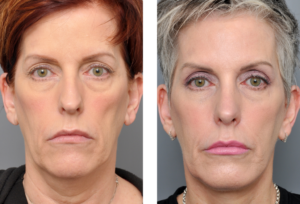Fat grafting, also known as fat transfer, is a popular and effective procedure in facial cosmetic surgery that enhances your natural beauty by restoring volume and improving contours. This technique involves harvesting fat from one area of your body and meticulously injecting it into specific facial areas to achieve a more youthful and balanced appearance.
Visit the Fat Grafting Before and After Gallery
Common Questions About Fat Grafting
What areas are usually treated?
Almost all areas of the face can be treated but there are the usually requested treatment sites:
- Correction of “hollow” eyes, visible vessels resulting in dark circles, as well as visible tear troughs
- Correction after aggressive removal of undereye fat fads from a lower blepharoplasty
- Temple areas
- Upper malar
- Sub malar
- Chin
- Lips (it isn’t a defining filler though)
- Jawline
- Forehead
- In-between the brow
- Facial scars
- Lower cheek after aggressive buccal fat extraction
- The area between upper lip and nose
- Bridge of the nose
- Anywhere else fat is needed or wanted
Many areas of the face and body can be treated with fat transfer, but the most common treatment indications are hollow appearing eyes and visible tear troughs, overly aggressive removal of fat pads during lower blepharoplasty, facial scars and depressions, and aggressive buccal fat removal or natural loss of fat in the lower cheeks. Fat transfer can also be used on the temple areas and temporal fat pads, upper malar and submalar areas, chin, lips, jawline, forehead, outer brow, and glabella, as well as between the upper lip and nose, on the bridge of the nose and lateral fatty pads, and anywhere else that fat is needed or wanted.











